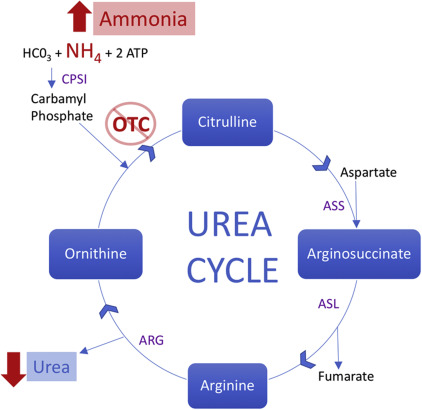Ornithine carbamoyltransferase deficiency (OTC deficiency) is a rare X-linked urea cycle disorder resulting from a mutation in the OTC gene, which encodes the mitochondrial enzyme ornithine transcarbamylase. This enzyme plays a pivotal role in the urea cycle, responsible for eliminating excess nitrogen by converting ammonia to urea. A deficiency leads to toxic accumulation of ammonia, known as hyperammonemia, with potentially life-threatening neurological consequences.

Urea Cycle and the Role of OTC Enzyme
The urea cycle is the body’s principal pathway for removing nitrogen waste generated from protein metabolism. Ornithine transcarbamylase catalyzes the reaction between carbamoyl phosphate and ornithine to form citrulline, a critical step in this cycle.
When OTC activity is deficient, carbamoyl phosphate accumulates, leading to excess ammonia and orotic acid in the body.
Genetic Basis and Inheritance Pattern
OTC deficiency is inherited in an X-linked recessive manner:
- Males with a defective OTC gene typically exhibit severe symptoms, often in the neonatal period.
- Heterozygous females may be asymptomatic or show variable symptoms due to lyonization (X-inactivation).
The disorder results from mutations in the OTC gene, located on Xp21.1.
Clinical Manifestations of OTC Deficiency
Neonatal-Onset Form (Severe)
Typically presents within 24–72 hours of birth with:
- Lethargy
- Poor feeding
- Vomiting
- Seizures
- Coma
- Respiratory alkalosis
Without prompt intervention, rapid progression to cerebral edema and death can occur.
Late-Onset Form (Mild to Moderate)
May present in childhood or adulthood, triggered by:
- High-protein diet
- Illness
- Fasting
- Postpartum state
Symptoms include:
- Intermittent confusion
- Behavioral changes
- Vomiting
- Headaches
- Ataxia
- Psychiatric disturbances
Some patients may remain undiagnosed until acute hyperammonemic crises occur.
Diagnostic Evaluation of OTC Deficiency
Biochemical Markers
- Elevated blood ammonia levels
- Low blood urea nitrogen (BUN)
- Elevated glutamine, alanine
- Elevated urinary orotic acid (pathognomonic)
Genetic Testing
- OTC gene sequencing identifies mutations
- Carrier testing in female relatives
- Prenatal diagnosis by chorionic villus sampling or amniocentesis
Imaging
- MRI of the brain in symptomatic patients may show cerebral edema or atrophy
Differential Diagnoses
- Other urea cycle disorders: CPS1 deficiency, ASS1 (citrullinemia), ASL deficiency
- Organic acidemias
- Sepsis
- Reye’s syndrome
- Mitochondrial disorders
Management of OTC Deficiency
Acute Hyperammonemic Crisis
Immediate interventions include:
- IV dextrose (10%) and lipids to suppress catabolism
- Nitrogen-scavenging agents:
- Sodium benzoate
- Sodium phenylbutyrate
- Hemodialysis if ammonia >200 µmol/L
- Intravenous arginine to support remaining urea cycle steps
Long-Term Management
- Low-protein diet with essential amino acid supplementation
- Chronic nitrogen scavengers
- Oral citrulline or arginine
- Regular monitoring of plasma ammonia, amino acids, and nutritional status
- Liver transplantation offers a potential cure and is considered in severe or recurrent cases
Monitoring and Prognosis
Monitoring Protocol
- Ammonia levels: frequent in the neonatal period or during illness
- Nutritional assessment: to ensure adequate growth
- Neurodevelopmental screening: for cognitive or motor delays
Prognostic Factors
- Neonatal onset generally portends worse outcomes
- Early detection and management significantly improve prognosis
- Female carriers require ongoing surveillance
Genetic Counseling and Family Planning
- Carrier detection essential in families with a known mutation
- Prenatal testing can be offered via chorionic villus sampling
- Preimplantation genetic diagnosis (PGD) is an option for at-risk couples
Genetic counseling should address recurrence risks, implications for siblings, and female carrier status.
Research and Emerging Therapies
Recent advances in gene therapy are under clinical evaluation, aiming to introduce functional OTC genes using adeno-associated virus (AAV) vectors. Enzyme replacement therapies and CRISPR-based editing offer future promise.
Frequently Asked Questions:
What triggers an OTC deficiency crisis?
Triggers include high-protein meals, infections, fasting, childbirth, or surgery.
Can females have symptoms of OTC deficiency?
Yes, due to random X-inactivation, heterozygous females may show symptoms ranging from mild to severe.
What is the role of orotic acid in diagnosis?
Elevated urinary orotic acid is a distinguishing marker of OTC deficiency due to excess carbamoyl phosphate being diverted into pyrimidine synthesis.
Is OTC deficiency curable?
Currently, only liver transplantation is considered curative. Otherwise, it’s a lifelong managed condition.
Can OTC deficiency be detected at birth?
Yes, through newborn screening or targeted testing in high-risk families.
Ornithine carbamoyltransferase deficiency is a serious yet manageable inborn error of metabolism with highly variable clinical presentations. Timely diagnosis, aggressive treatment of hyperammonemic episodes, tailored dietary management, and ongoing surveillance are essential to mitigate long-term complications. Advances in gene therapy may soon transform the prognosis of this rare but life-threatening disorder.